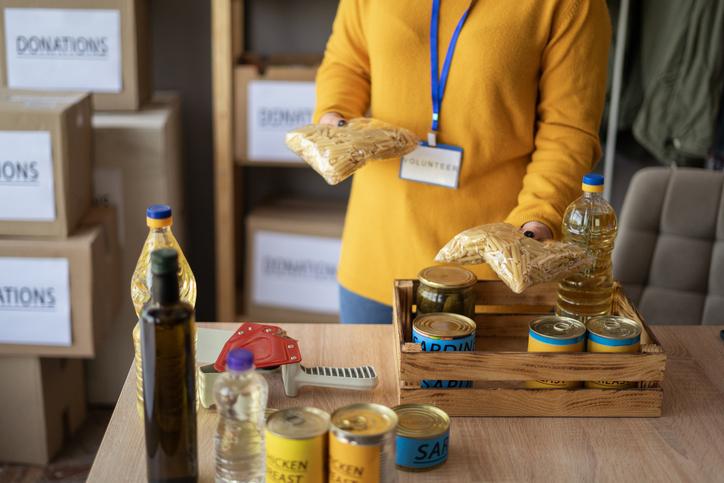
A food pantry can help support your campus through the cost-of-living crisis

Inflation in the US has significantly increased the cost of living for many Americans, and students are not immune to this stressful reality – in fact, studies show that between 30 and 40 per cent of college students are food insecure, rates that are two to four times that of the general US population.
Insufficient access to food and other basic needs, such as clothing and stable housing, profoundly affects individuals and can compromise students’ academic performance, mental health and physical well-being.
In 2016, Montclair State University became the first four-year university in New Jersey to open an on-campus food pantry. The Red Hawk Pantry is the outcome of a campus-wide survey conducted to assess the basic needs of our campus community. The results showed that 10-15 per cent of survey participants expressed some level of food insecurity on a regular basis, signalling the need for action in order to best serve our campus’ growing and diverse population.
- A ‘grocery store’ model can help your campus food bank reduce waste
- Food for thought: advice for building a university-community collaboration
- We won’t get anywhere without placing the SDGs in local contexts
Our community food pantry is a crucial source of support for the entire campus community. It serves as a vital cushion for individuals who lack the means to shop after work or classes, offering a resource to alleviate the financial strain caused by higher living costs and rising college prices.
Since Red Hawk Pantry opened, Montclair has also been designated by the state of New Jersey as a hunger-free campus, in acknowledgement of the university’s dedication and progress towards addressing student food needs.
Here are some of the key elements necessary to establish a successful food pantry on campus:
Tips for setting up a food pantry on campus
1. What are your campus’ needs?
Conduct a thorough needs assessment to understand the level of food insecurity among students and staff. The USDA food security survey can be administered annually to determine food insecurity rates, but be sure to also include questions specific to your campus and its demographics. Together, this data can guide details such as the pantry’s size, resources and the types of food items needed.
2. Who can help you?
Get buy-in from your stakeholders, including students, staff, faculty, senior leadership and donors. It might be helpful to facilitate focus groups or information sessions to educate the community about food insecurity and share survey results.
3. How much will it cost to set up?
Identify your start-up costs and work with the development team at your institution if you need to embark on fundraising efforts.
4. Establish a timeline
Develop an infrastructure plan and timeline. You will need to find a location, decide hours of operation, levels of staffing, suppliers and a tracking system for inventory management and user data. Choose a central location on campus that is accessible and convenient.
5. Network with your communities
There’s no need to reinvent the wheel. Visit similar operations at other campuses and in the local community; ask questions, take notes and start building a network. Our on- and off-campus partners include:
- the university’s nutrition and public health departments, which offer guidance, research and education on the importance of food security
- the Montclair State University Community Garden, which assists in the cost-efficiency of the pantry, ensuring that visitors have access to fresh produce and reducing reliance on external suppliers
- local food pantries, businesses and community organisations (establishing partnerships can help secure donations and reduce operational costs; the university foundation can assist with developing these outside partnerships)
- departments and student organisations can host food drives. For us, an unlikely partner is parking services. Each semester they host Cans for Citations, where students can donate canned goods to the pantry to pay off parking tickets.
Remember that support goes both ways. Red Hawk Pantry staff actively participate in campus events, an approach that fosters an environment where accessing the pantry is normalised and seen as a positive and inclusive aspect of campus life.
Recipe for success in running a campus food pantry
Once the plans and infrastructure are in motion, you can turn to the day-to-day running of your pantry. Here are tips that have worked for us.
- Provide a diverse range of foods to accommodate varied dietary needs and preferences.
- Prioritise nutritionally balanced choices.
- Provide personal-care items and other non-food essentials to address broader needs beyond nutrition.
- Create a welcoming and confidential space for pantry users to maintain their dignity.
- Offer extended hours to accommodate diverse student schedules. This will also help to destigmatise the use of the pantry, because the goal is for the pantry to be viewed as any other resource on campus.
- Have a plan to promote the pantry and establish clear communication channels, such as through social media or campus announcements, to reach those in need.
- Regularly assess the pantry’s impact through surveys and feedback mechanisms, allowing for continuous improvement. One helpful resource is the Healthy Food Pantry Assessment Toolkit.
- Comply with campus regulations and local health standards to guarantee a safe and hygienic environment.
The pantry is not the only campus initiative that could free up students’ money for their food budgets. Other complementary campus services could include community fridges, meal swipe donations, food recovery programmes, nutrition/food budgeting/meal preparation workshops, SNAP (Supplemental Nutrition Assistance Program) enrolment assistance and SNAP purchasing options on campus.
Non-food types of support at your institution, such as clothing swaps, professional clothing donations, housing assistance, on-campus job opportunities, public transportation options and on-campus childcare programmes, can also help to ease financial pressure.
Once the pantry is established, make sure everyone on campus is invited to visit, even those who are not personally dealing with food insecurity. Through word of mouth, your food pantry’s services could reach someone in need.
Lauren Dinour is an associate professor of nutrition and Fatima deCarvalho is senior associate dean of students; both are on Montclair State University’s hunger-free campus task force. Karina Escobar is coordinator for student access to community services at Montclair State University and helps to oversee the Red Hawk Pantry.
If you would like advice and insight from academics and university staff delivered direct to your inbox each week, sign up for the Campus newsletter.
Additional Links
For more advice and resources on this topic, go to our Spotlight collection Helping students through the cost-of-living crisis.


